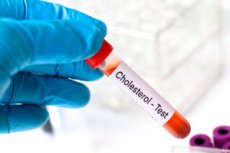Nowe publikacje
Im więcej cholesterolu, tym więcej bólu.
Last reviewed: 29.06.2025

Cała zawartość iLive jest sprawdzana medycznie lub sprawdzana pod względem faktycznym, aby zapewnić jak największą dokładność faktyczną.
Mamy ścisłe wytyczne dotyczące pozyskiwania i tylko linki do renomowanych serwisów medialnych, akademickich instytucji badawczych i, o ile to możliwe, recenzowanych badań medycznych. Zauważ, że liczby w nawiasach ([1], [2] itd.) Są linkami do tych badań, które można kliknąć.
Jeśli uważasz, że któraś z naszych treści jest niedokładna, nieaktualna lub w inny sposób wątpliwa, wybierz ją i naciśnij Ctrl + Enter.

Niektóre lipidy w strukturze komórki – w tym cholesterol – zapobiegają tworzeniu się kanałów jonowych w komórkach nerwowych, które mogłyby łagodzić ból.
Szybka transformacja działania mechanicznego w impuls biologiczny pomaga strukturom komórkowym reagować na tego typu efekty środowiskowe.
Ciało ma to wszystko rozpracowane: jeśli ból, powinien ustąpić, gdy tylko zniknie przyczyna. Na przykład, osoba jest poturbowana i przy braku poważnych urazów, ból stopniowo ustępuje. W takiej sytuacji zespół bólowy działa jak rodzaj sygnału wskazującego na możliwe niebezpieczeństwo.
Wiadomo również, że nie wszyscy ludzie mają taką samą wrażliwość na ból. A jeśli nie rozważymy tego problemu na poziomie molekularnym, jaki może być sens?
Moment bólu to okres przewodzenia drgania nerwowego, które trwa od stłuczonego (uszkodzonego) obszaru do określonej części mózgu. Aby zapewnić ten proces, błona komórkowa nerwowa musi przegrupować jony. W przypadku receptorów przegrupowanie to jest spowodowane wpływami zewnętrznymi. Błony komórkowe nerwowe zawierają specyficzny kanał białkowy dla jonów, który działa jako środek znieczulający. Ten kanał zawiera aktywujący enzym fosfolipazę, który jest aktywowany, gdy jest potrzebny do ukojenia bólu.
Ponieważ zarówno pierwsze, jak i drugie białko „ukrywają się” w błonie, ważne jest, z czym wchodzą w interakcję. Istnieją różne lipidy, w tym nasycone kwasy tłuszczowe i cholesterol, które tworzą coś podobnego do skrzepów otoczonych inną kategorią lipidów. Enzym aktywujący wydaje się „dokować” do tych skrzepów i „odpoczywać” do momentu działania mechanicznego, wiążąc się z innym lipidem, z którym uruchamia przejście jonów przeciwbólowych.
Śledząc powyższy pas pulsu, możemy wyjaśnić, dlaczego osoba próbuje dokładnie pocierać bolące miejsce po urazie. Umiarkowany nacisk na bolesny obszar sprzyja aktywacji pomocniczych cząsteczek przeciwbólowych. Jednocześnie cholesterol komplikuje taką aktywację: enzymowi trudno jest „odkleić się” od gęstych lipidów. Jest prawdopodobne, że osoby z silną wrażliwością na ból mają pewne zaburzenia metabolizmu lipidów, które mogą być związane z cukrzycą, zmianami związanymi z wiekiem itd.
Być może teraz naukowcy powinni pomyśleć o opracowaniu nowych leków, które byłyby w stanie oddziaływać na „interferencje” w postaci kompleksów lipidowych w błonach komórkowych, a także na substancje białkowe z nimi związane.
Pełne szczegóły badania można znaleźć na stronie magazynu eLife pod adresem
